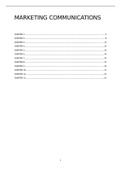Samenvatting
Samenvatting en college-aantekeningen van Marketing Communication
- Instelling
- Radboud Universiteit Nijmegen (RU)
Dit is een samenvatting van het boek Marketing Communications: A European perspective, 7th edition. Tevens bevat het college-aantekeningen. Dit document bevat alles wat je nodig hebt voor het tentamen van het Marketing Communication bij de studie Communicatie- en Informatiewetenschappen of Internat...
[Meer zien]





